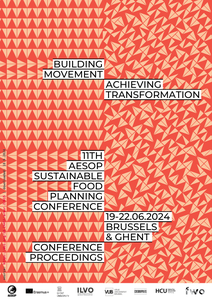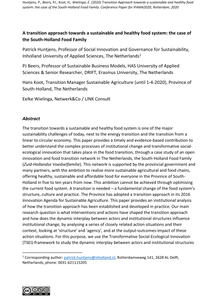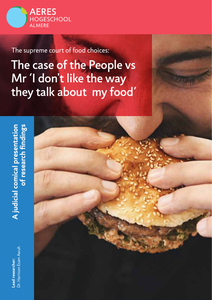Moral food lab: Transforming the food system with crowd-sourced ethics
LINK
Citizens living in food poverty can easily get caught up in a vicious cycle. Socio-economically disadvantaged people often rely on food assistance and are more likely to suffer from diseases caused by unhealthy diets, such as diabetes. They may also experience isolation and lack social networks, as they do not have the financial means to participate in social life. Moreover, this group is often overlooked in decision-making processes regarding healthy and sustainable food environments. To create equitable food environments in urban areas, it is crucial to incorporate the everyday challenges and needs of socioeconomically disadvantaged people. In our collaborative research, we explore the needs of socioeconomically disadvantaged people regarding a healthy and sustainable diet in Switzerland and the Netherlands. The aim is also to develop, in a participatory way, ideas on how to create more socially just and inclusive food environments.Keywords: food poverty, food environments, social participation, participatory action research
DOCUMENT

The transition towards a sustainable and healthy food system is one of the major sustainability challenges of today, next to the energy transition and the transition from a linear to circular economy. This paper provides a timely and evidence-based contribution to better understand the complex processes of institutional change and transformative social-ecological innovation that takes place in the food transition, through a case study of an open innovation and food transition network in The Netherlands, the South-Holland Food Family (Zuid-Hollandse Voedselfamilie). This network is supported by the provincial government and many partners, with the ambition to realize more sustainable agricultural and food chains, offering healthy, sustainable and affordable food for everyone in the Province of South-Holland in five to ten years from now. This ambition cannot be achieved through optimising the current food system. A transition is needed – a fundamental change of the food system’s structure, culture and practice. The Province has adopted a transition approach in its 2016 Innovation Agenda for Sustainable Agriculture. This paper provides an institutional analysis of how the transition approach has been established and developed in practice. Our main research question is what interventions and actions have shaped the transition approach and how does the dynamic interplay between actors and institutional structures influence institutional change, by analysing a series of closely related action situations and their context, looking at 'structure' and 'agency', and at the output-outcomes-impact of these action situations. For this purpose, we use the Transformative Social-Ecological Innovation (TSEI)-framework to study the dynamic interplay between actors and institutional structures influencing institutional change. The example of TSEI-framework application in this paper shows when and how local agents change the institutional context itself, which provides relevant insights on institutional work and the mutually constitutive nature of structure and agency. Above institutional analysis also shows the pivotal role of a number of actors, such as network facilitators and provincial minister, and their capability and skills to combine formal and informal institutional environments and logics and mobilize resources, thereby legitimizing and supporting the change effort. The results are indicative of the importance of institutional structures as both facilitating (i.e., the province’s policies) and limiting (e.g. land ownership) transition dynamics.
DOCUMENT

Purpose: Food waste occurs in every stage of the supply chain, but the value-added lost to waste is the highest when consumers waste food. The purpose of this paper is to understand the food waste behaviour of consumers to support policies for minimising food waste. Design/methodology/approach: Using the theory of planned behaviour (TPB) as a theoretical lens, the authors design a questionnaire that incorporates contextual factors to explain food waste behaviour. The authors test two models: base (four constructs of TPB) and extended (four constructs of TPB plus six contextual factors). The authors build partial least squares structural equation models to test the hypotheses. Findings: The data confirm significant relationships between food waste and contextual factors such as motives, financial attitudes, planning routines, food surplus, social relationships and Ramadan. Research limitations/implications: The data comes from an agriculturally resource-constrained country: Qatar. Practical implications: Food waste originating from various causes means more food should flow through the supply chains to reach consumers’ homes. Contextual factors identified in this work increase the explanatory power of the base model by 75 per cent. Social implications: Changing eating habits during certain periods of the year and food surplus have a strong impact on food waste behaviour. Originality/value: A country is considered to be food secure if it can provide its citizens with stable access to sufficient, safe and nutritious food. The findings and conclusions inform and impact upon the development of food waste and food security policies.
MULTIFILE
DOCUMENT
This study proposes a systematic value chain approach to helping businesses identify and eliminate inefficiencies. The authors have developed a robust framework, which food-sector entrepreneurs can use to increase profitability of an existing business or to create new profitable opportunities. The value chain approach provides win-win opportunities for players within the value chain. To test the robustness of the framework, the authors use food waste as an example of a critical inefficiency and apply it to two different food sector business cases, each operating in diverse conditions. Because the suggested framework addresses the core elements and parameters for the existence and competitiveness of a business, the model can be adapted to other sectors.
DOCUMENT

This booklet outlines a 'court case' about shaming someone's food choices. Dit boekwerk behandelt een 'rechtszaak' over het te schande maken van iemands voedselkeuzes.
DOCUMENT

The EU-28’s food service sector generates excessive amounts of food waste. This notwithstanding, no comparative, cross-national research has ever been undertaken to understand how food waste is managed in restaurants across the EU-28. This study contributes to knowledge by presenting a first attempt to conduct a comparative analysis of restaurant food waste management practices in the UK and the Netherlands. It finds that although restaurateurs in both countries use demand forecasting as a prime approach to prevent food waste, forecasting does not always work. When this happens, food waste management programmes such as repurposing excess foodstuffs, redistribution of surplus food and consumer choice architecture are mostly considered commercially unviable. To improve the effectiveness of food waste management in the food service sectors of the UK and the Netherlands it is necessary to ensure that food waste mitigation becomes a corporate target for restaurateurs and the progress towards its achievement is regularly monitored by top management. This corporate commitment should be facilitated by national policy-makers, but also by EU regulators, by raising consumer awareness of food waste, incentivising surplus food redistribution and enabling food waste recycling.
LINK
Food and the city has never been a more urgent theme than today, and The European Union’s priority to commit to innovation in this field will certainly enhance its economic and external strength and improve its competitive position in the world of food and life sciences. Europea Netherlands held a seminar on this topic in May 2016, during the Dutch EU presidency.To be part of this international endeavour, the Netherlands need to strengthen the digital market, support innovation in the internal market, boost domestic policy reforms, and embed their knowledge and skills in a European society that challenges itself and continues to innovate. The Netherlands is a global player in the agro, food and horticultural sector and a major player in the export market of agricultural products. This sector is one of its main economic pillars. New knowledge is being developed as we speak, which is also an export product in high demand, providing sizeable employment. This is only possible because the sector is innovative and remains up-to-date. The peri-urban areas in the Netherlands (both urban and rural areas) are characterized by high population density. This necessitates thinking about manufacturing, food, logistics and water management(circular economy). Land-based education and life sciences in the Netherlands may appear to be specific, yet it is broad too: the primary sectors are included, as well as the manufacturing businesses and services associated with it. Participants learn to work in an innovative sector in a society in transition, bringing together multiple disciplines (cross-overs) and stakeholders. This education is practical and has a strong connection to the industry. During the Europea seminar five professorships, installed by the ministry of Economic Affairs, focused on transitions in the agro and food sector. The five professorships are posted at the Dutch Agricultural Universities of applied sciences, including teacher education for sustainable connected learning and development for professional education and business communities.
DOCUMENT

Food and the city has never been a more urgent theme than today, and The European Union’s priority to commit to innovation in this field will certainly enhance its economic and external strength and improve its competitive position in the world of food and life sciences. Europea Netherlands held a seminar on this topic in May 2016, during the Dutch EU presidency.To be part of this international endeavour, the Netherlands need to strengthen the digital market, support innovation in the internal market, boost domestic policy reforms, and embed their knowledge and skills in a European society that challenges itself and continues to innovate. The Netherlands is a global player in the agro, food and horticultural sector and a major player in the export market of agricultural products. This sector is one of its main economic pillars. New knowledge is being developed as we speak, which is also an export product in high demand, providing sizeable employment. This is only possible because the sector is innovative and remains up-to-date. The peri-urban areas in the Netherlands (both urban and rural areas) are characterized by high population density. This necessitates thinking about manufacturing, food, logistics and water management(circular economy). Land-based education and life sciences in the Netherlands may appear to be specific, yet it is broad too: the primary sectors are included, as well as the manufacturing businesses and services associated with it. Participants learn to work in an innovative sector in a society in transition, bringing together multiple disciplines (cross-overs) and stakeholders. This education is practical and has a strong connection to the industry. During the Europea seminar five professorships, installed by the ministry of Economic Affairs, focused on transitions in the agro and food sector. The five professorships are posted at the Dutch Agricultural Universities of applied sciences, including teacher education for sustainable connected learning and development for professional education and business communities.
DOCUMENT

Food and the city has never been a more urgent theme than today, and The European Union’s priority to commit to innovation in this field will certainly enhance its economic and external strength and improve its competitive position in the world of food and life sciences. Europea Netherlands held a seminar on this topic in May 2016, during the Dutch EU presidency.To be part of this international endeavour, the Netherlands need to strengthen the digital market, support innovation in the internal market, boost domestic policy reforms, and embed their knowledge and skills in a European society that challenges itself and continues to innovate. The Netherlands is a global player in the agro, food and horticultural sector and a major player in the export market of agricultural products. This sector is one of its main economic pillars. New knowledge is being developed as we speak, which is also an export product in high demand, providing sizeable employment. This is only possible because the sector is innovative and remains up-to-date. The peri-urban areas in the Netherlands (both urban and rural areas) are characterized by high population density. This necessitates thinking about manufacturing, food, logistics and water management(circular economy). Land-based education and life sciences in the Netherlands may appear to be specific, yet it is broad too: the primary sectors are included, as well as the manufacturing businesses and services associated with it. Participants learn to work in an innovative sector in a society in transition, bringing together multiple disciplines (cross-overs) and stakeholders. This education is practical and has a strong connection to the industry. During the Europea seminar five professorships, installed by the ministry of Economic Affairs, focused on transitions in the agro and food sector. The five professorships are posted at the Dutch Agricultural Universities of applied sciences, including teacher education for sustainable connected learning and development for professional education and business communities.
DOCUMENT
